New Mexico is sweltering, culturally diverse, and filled to the brim with fascinating bird species. If you’re a fan of songbirds, you’ll be happy to know there are 14 finches you can spot!
What makes finches so common in this state, anyway? It could have something to do with how comfortable these songbirds are in a variety of environments.
While some finch species prefer forests, there are several more that enjoy wide, open spaces. Combine that with some finches having unpredictable migration patterns and you have an equation that equals dynamic bird watching.
It’s been a while since I’ve been to New Mexico, so let’s go on a journey to learn about the 14 species found there. I’ll help you spot them by their appearance, bird song, and much more.
Blue Grosbeak
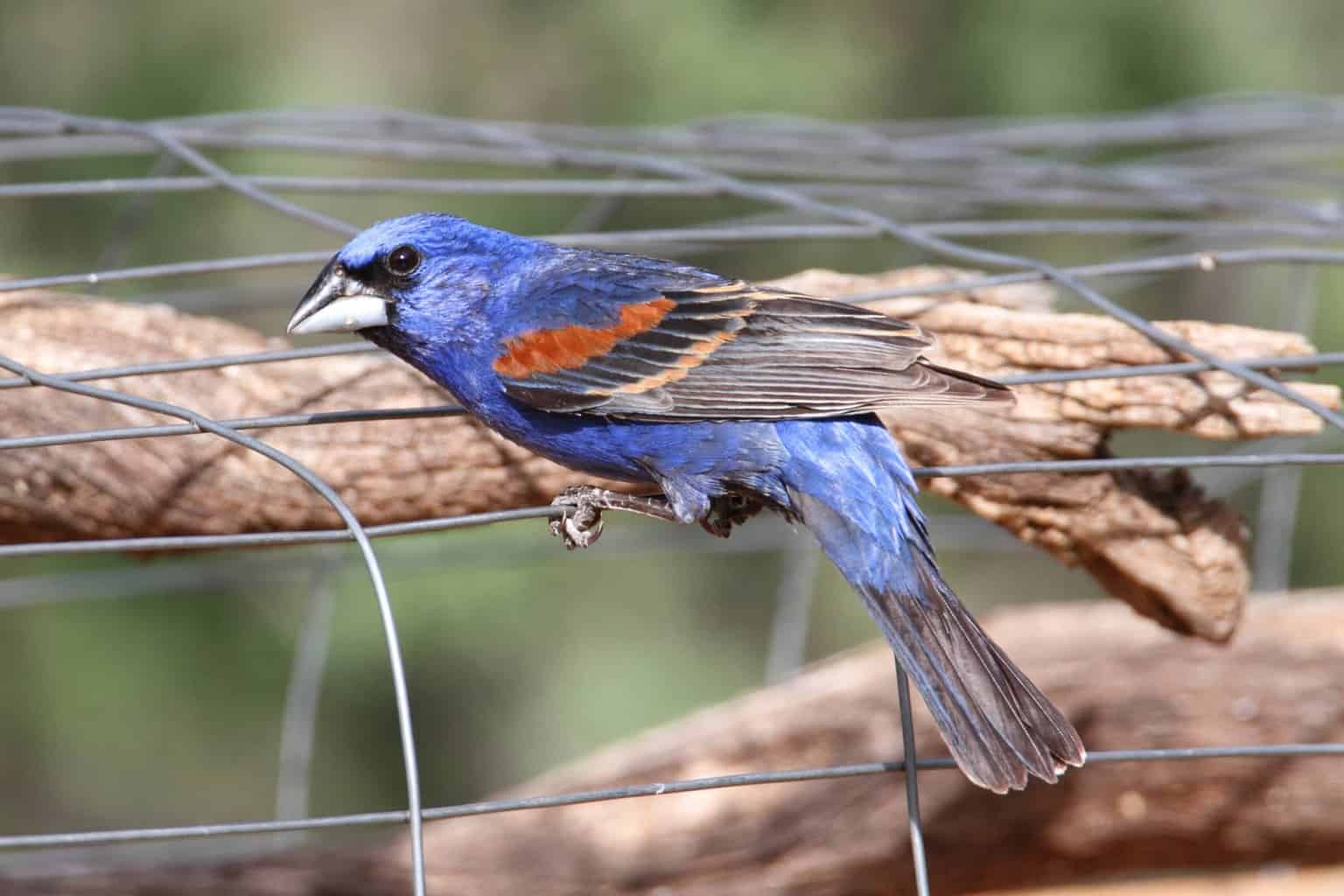
- Species Name: Passerina caerulea
- Length: 14 cm to 19 cm
- Weight: 26 grams to 31 grams
- Wingspan: 26 cm to 29 cm
Let’s usher in this journey through New Mexico with one of the most striking finches in the finch family. This unique bird has coloration that’s easy to confuse with other species, such as the Indigo Bunting or Western Blue Bird.
Appearance
Male blue grosbeaks stun with their sapphire blue feathers and large, pale bill. They have a mixture of black and chestnut brown banding around their wings.
The female blue grosbeak is just as beautiful in her more subtle coloration. Her head is a nutty brown that transitions to gray and blue near her rump.
Range
Blue grosbeaks are a pretty common sight in most of New Mexico once the breeding season hits. They’re a little more scarce up north, though.
A major reason why these finches are so comfortable in the state is due to the abundance of semi-open areas. They love to nestle into forest edges, thickets, and hedgerows.
Diet
Blue grosbeaks are rather interesting due to their love of insects. They’ll often forage or fly in search of spiders, beetles, grasshoppers, and snails.
However, they’ll also eat the occasional berry or seed. You may be able to attract them to your feeder with black oil sunflower seeds.
Here’s a tip – place your feeder somewhere overgrown and shrubby. This location more closely mimics their natural behavior and helps them feel safe enough to linger.
Birdsong
These lovely birds have a soft and lilting warble that sometimes ends in buzzing trills.
Fun Fact
Blue grosbeaks are a rather odd member of the finch family. Recent scientific discovery has found they’re also closely related to cardinals, a similar yet distinct songbird.
House Finch

- Species Name: Haemorhous mexicanus
- Length: 13 cm to 14 cm
- Weight: 16 grams to 27 grams
- Wingspan: 20 cm to 25 cm
It’s not a celebration of finches without the classic house finch! This common bird shows up throughout New Mexico all year round.
Appearance
The male house finch has a charming red head and chest with a soft brown body. He looks a little similar to a purple finch but with more brown than red.
The female house finch is rather different, boasting a light brown body covered in streaks.
Males and females have notched tails, darker legs, and the classical conical bill of finches.
Range
You won’t have to travel far to see house finches in New Mexico. Backyard birders and hikers alike will be able to enjoy their sociable flocks.
House finches are comfortable in gardens, backyards, and parks alike. They’ll even show up in the occasional neighborhood or downtown area.
Diet
These sociable birds are avid foragers who will eat seeds, insects, and berries alike. They’re most likely to show up in your backyard if you use a tube feeder.
Try to attract house finches with hearty helpings of nyjer and sunflower seeds. Just be mindful, as they’re a little aggressive and may scare off other birds while they’re feeding!
Birdsong
The house finch has one of the most delightful warbles around. Expect to hear sweet, jaunty chrp-chrp notes mixed with rising and falling warbles.
Fun Fact
The house finch has a sweet mating ritual. The female house finch will pretend to be a hungry chick and the male will feed her to show his devotion.
American Goldfinch

- Species Name: Spinus tristis
- Length: 11 cm to 13 cm
- Weight: 11 grams to 20 grams
- Wingspan: 19 cm to 22 cm
Do you prefer to watch birds from the comfort of your backyard? The American goldfinch is a staple for bird watchers since they love to gather and chatter at feeders.
Appearance
The male American goldfinch has brilliant lemon-yellow plumage with black wings and white wing bars. He has a little black cap around his eyes and a vivid orange bill.
The female American goldfinch looks similar, but veers toward an olive color with no black cap.
Range
These colorful finches show up throughout the entire state during non-breeding season. They prefer to migrate up north when they’re ready to mate.
American goldfinches regularly show up in spacious meadows, fields, and gardens. They also love to visit backyard bird feeders to mingle with other birds and get an easy meal.
Diet
Unlike most finches, the American goldfinch prefers to stick to weeds and seeds. They spend a lot of time searching for dandelion, thistle, and ragweed seeds.
That said, they will entertain the occasional insect or berry when their food supply gets low. Usher them to your backyard with thistle or sunflower seeds – you may get to see an entire flock!
Birdsong
American goldfinches have a sharp and sweet call. You’ll hear some sharp chwee-chwee-chwees mixed with very long warbles.
Fun Fact
The male American goldfinch looks quite similar to the female American goldfinch once breeding season ends. When he’s not ready to mate, his feathers also develop an olive-yellow hue.
Lesser Goldfinch

- Species Name: Spinus psaltria
- Length: 9 cm to 12 cm
- Weight: 8 grams to 11 grams
- Wingspan: 20 cm
These charming little birds are among the smallest in the finch family. Despite their tiny size, they make up the difference with very large flocks and a wonderful singing voice.
Appearance
The male lesser goldfinch has a black body with a bright yellow stomach and small white wing bars. His conical bill has an almost silvery coloration.
The female lesser goldfinch has a gentle yellow-olive body with brown wings and a gray bill.
Range
These social birds are pretty easy to spot in New Mexico. Expect to see them in the southern portion of the state year-round, though they stick to breeding season up north.
Lesser goldfinches are big fans of shrubs but actually tend to avoid dense forests. These are the kinds of birds you’ll more easily spot during a nature walk than a camping trip.
Diet
Thistle and sunflower seeds are their main food supply, though they also nibble on flower buds. They may eat insects if they’re in a particularly sparse area.
Try attracting these birds to your feeder with sunflower or thistle seeds.
Birdsong
These finches have a rather sharp and metallic call. Expect to hear chirps mixed with pinging cheeg-cheeg notes.
Fun Fact
You know you’re legendary when you go by many names. The lesser goldfinch used to be dubbed the greenback goldfinch.
Lawrence’s Goldfinch

- Species Name: Spinus lawrencei
- Length: 10 cm to 12 cm
- Weight: 9 grams to 14 grams
- Wingspan: 21 cm
Now this is a very interesting finch! Lawrence’s goldfinch prefers to march to the beat of their own drum, boasting a rather erratic migration pattern.
Appearance
It’s time for a crash course on how not to confuse your finches. Lawrence’s goldfinch looks similar to the American goldfinch and the lesser goldfinch.
Adult males have a light gray body with a yellow belly and black face. They have a notched tail and pale bill.
Females have light gray bodies with faint hints of yellow on their chests and wings.
You’ll notice that Lawrence’s goldfinch is a little longer and heavier than the lesser goldfinch. It’s also less yellow than the American goldfinch.
Range
This finch is a wanderer. They show up in southern New Mexico during non-breeding season but are scarce further up north.
These birds enjoy lowlands and desert areas, but may still travel toward sources of water. As such, this is one finch to keep a sharp eye out for, no matter where you are in southern New Mexico.
Diet
Amaranth and inkweed are their favorite plants to pick seeds from, but they branch out occasionally. You’ll increase your chances of attracting them to your backyard feeders with nyjer seeds.
Birdsong
While this finch is easy to confuse with other finches visually, it’s impossible to confuse by birdsong. Lawrence’s goldfinch has an incredibly dynamic and vivacious song of cheets, chirps, and trills.
You may even hear notes that sound like chr-chr-chr-chr-cheee.
Fun Fact
Lawrence’s goldfinch will also vary their migration depending on how often it’s raining.
Black Rosy-Finch

- Species Name: Leucosticte atrata
- Length: 14 cm to 16 cm
- Weight: 22 grams to 32 grams
- Wingspan: 33 cm
While the first handful of finches on this list are quite common in the state, the black rosy-finch is a bird watcher’s challenge. This finch is rarer in the state since they usually prefer colder environments.
Appearance
The male black rosy-finch has a beautiful chocolate brown body with light gray wings and a patch of gray on his head. He earns his name with a sprinkle of rosy pink along his belly.
Female black rosy-finches look rather similar but have less pink along their stomach.
Range
Black rosy-finches usually explore distant, mountainous summits and alpine tundras. However, they sometimes visit spacious meadows and fields to dig around for food.
Expect to see these plump finches sparingly during the fall and winter months in New Mexico.
Diet
These stocky finches enjoy a varied diet of insects, seeds, and flower buds. Interestingly enough, they also eat quite a few leaves.
If you want to attract these finches to your bird feeder, try scattering black oil sunflower seeds or nyjer seeds on the ground. These birds are natural foragers and will feel comfortable when you replicate their natural feeding habits.
Birdsong
Their larger size belies a rather dainty, simple finch song. Expect to hear soft, gentle chirps in slow succession.
Fun Fact
Black rosy-finches will use a natural pouch to store food for long distances. This feature enables them to travel further from their nest site.
Brown-Capped Rosy-Finch

- Species Name: Leucosticte australis
- Length: 14 cm to 16 cm
- Weight: 23 to 33 grams
- Wingspan: 33 cm
I never tire of this finch’s incredible plumage. These birds have a romantic coloration that’s been the subject of many of my drawings.
Appearance
The brown-capped rosy-finch lives up to its name with a tan body, dark brown wings, and white wing bars. They have a darker brownish head and a pop of blushy red along their stomach.
Sometimes you’ll see a little rosy red on their wing bars, too. This reddish color gets brighter during the breeding season and then dims during the non-breeding season.
Range
If you want to see this finch, it’s time to strap on your hiking boots and hit the open trail. New Mexico has a plethora of mountainous hiking trails where these birds will be rooting for insects and seeds.
If you prefer to hang out in your backyard, you’ll want to stock up on seeds.
Diet
Brown-capped rosy-finches are often busy foraging for weed seeds as well as grasses and insects. They’ll visit your feeder if you have plenty of black oil sunflower seeds.
However, a platform feeder might be better for these birds due to their larger size.
Birdsong
This finch’s song is sweet and rather sharp. Expect slow, yet consistent cheeping and chirping.
Fun Fact
These birds, quite literally, live life on the edge. They prefer to build their nests in extremely high elevations.
Gray-Crowned Rosy-Finch

- Species Name: Leucosticte tephrocotis
- Length: 14 cm to 21 cm
- Weight: 22 grams to 60 grams
- Wingspan: 33 cm
A finch you may confuse for the brown-capped rosy-finch is the similar gray-crowned rosy-finch. Despite similar coloration, they have plumage different enough for you to tell them apart.
Appearance
The male gray-crowned rosy-finch has a warm yellow-brown body with blushing wings and a gray head. Their beaks tend to be darker than their female counterparts.
Unlike brown-capped rosy-finches, the gray-crowned rosy-finch has gray wrapping around its head and face.
The female gray-crowned rosy-finch has a mottled body of gray, brown, and pink. Her beak is a bright yellow and stands out stark against their male counterparts.
Range
These finches are rarer in New Mexico and will likely only be glimpsed by hikers, campers, and mountain climbers. They’re huge fans of high elevations and will stick around mountains or cliff edges.
Expect to see these finches only up north during non-breeding season, to boot. As the saying goes: timing is everything!
Diet
These finches switch up their diet depending on the season. They prefer insects during the summer but prefer seeds and grasses during the winter.
Since these birds prefer higher elevations, does that mean you should give up your backyard birding aspirations? As it stands, they may still visit if you scatter black oil sunflower seeds on the ground.
Birdsong
This finch’s birdcall is a quirky one! Instead of the sharper whistles and cheeps of their cousins, they have a mumbling and low chatter.
Fun Fact
Gray-crowned rosy-finches take breeding season very seriously. The males will not only protect the nest but will follow their mate around and protect her as she forages.
Pine Siskin
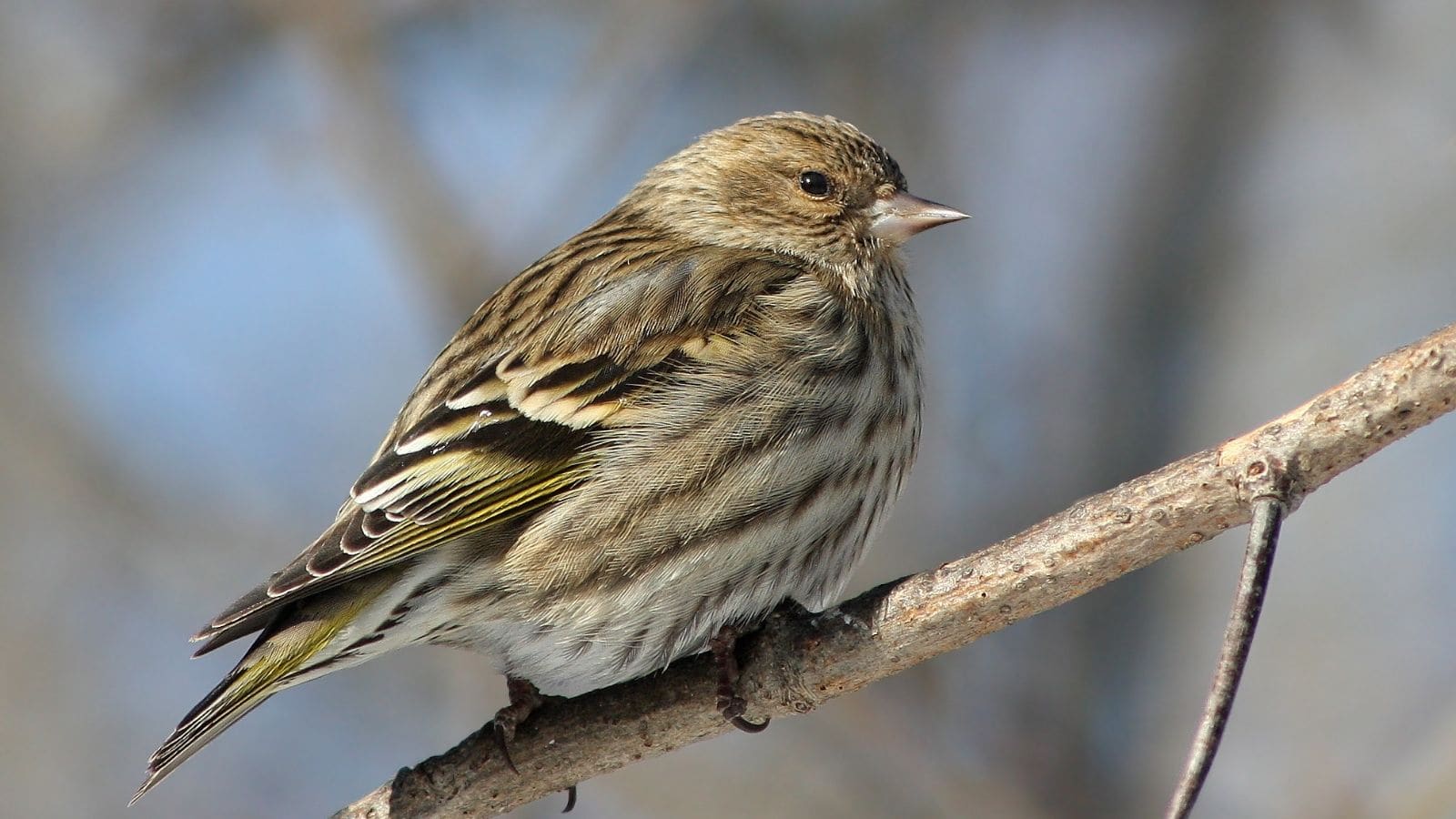
- Species Name: Spinus pinus
- Length: 11 cm to 14 cm
- Weight: 12 grams to 18 grams
- Wingspan: 18 cm to 22 cm
New Mexico may not be the most forested state in the country, but it still has enough to attract the tiny pine siskin. This finch is a dedicated fan of forests and spends most of their time there.
Appearance
This finch is an odd fellow for his delicate appearance and skinny bill. He has a light tan-yellow body covered in flecks, helping him blend into the dappled light of forests.
Female pine siskins look quite similar to the males but have a little less yellow on their wings.
Range
These finches are common year-round in the eastern portion of the state. Western New Mexico usually sees them during non-breeding season.
Deciduous forests are their favorite places to roam and New Mexico actually has a few! The Carson National Forest is one of their best-known and is filled with the evergreen trees that pine siskins love.
Diet
These birds spend much of their time foraging for seeds but sometimes eat plant matter and insects.
Since their beaks are small, try using smaller seeds such as thistle to attract them.
Birdsong
Pine siskins have a charming song that sounds like they’re permanently delighted. Expect to hear long, buzzing tzweees.
Fun Fact
The pine siskin’s mating dance is technically longer than other finches. Even after a pair forms a bond, the male will still continue to sing and offer food gifts to the female.
Red Crossbill

- Species Name: Loxia curvirostra
- Length: 14 cm to 17 cm
- Weight: 40 grams
- Wingspan: 25 to 27 cm
Red crossbills are one of the easier finches to find due to their range and their diverse foraging habits. In fact, they’re quick to shake things up and show up in unexpected areas.
Appearance
The male red crossbill has a rich, brick-red or yellow-orange body with gray-brown wings. Their white wing bars are on the thinner side and their thick, crossed bill looks almost parrot-like.
The female red crossbill goes for a different approach with her gray body and yellow-orange patches. She also has the same crossed beak.
Range
Since red crossbills need to eat seeds, they generally stick to deciduous, coniferous, and mixed forests. However, they’re not afraid to leave to find new food supplies (often during winter).
Expect to see these birds throughout New Mexico year-round, though they get a little scarce in the southeastern portion of the state.
Diet
Red crossbills are big fans of seeds, but will also nibble along the ground for rock salt. You can try bringing them to your bird feeding station with black oil sunflower seeds.
Birdsong
Their song is lilting and rapid-fire with soft chirps and cheeps. They may sometimes switch to bright, happy trills.
Fun Fact
Their crossed beak isn’t an accident, but an adaptation to their love of pine cones. Their beak shape makes it easy to slip between the cracks and pull out seeds.
White-Winged Crossbill
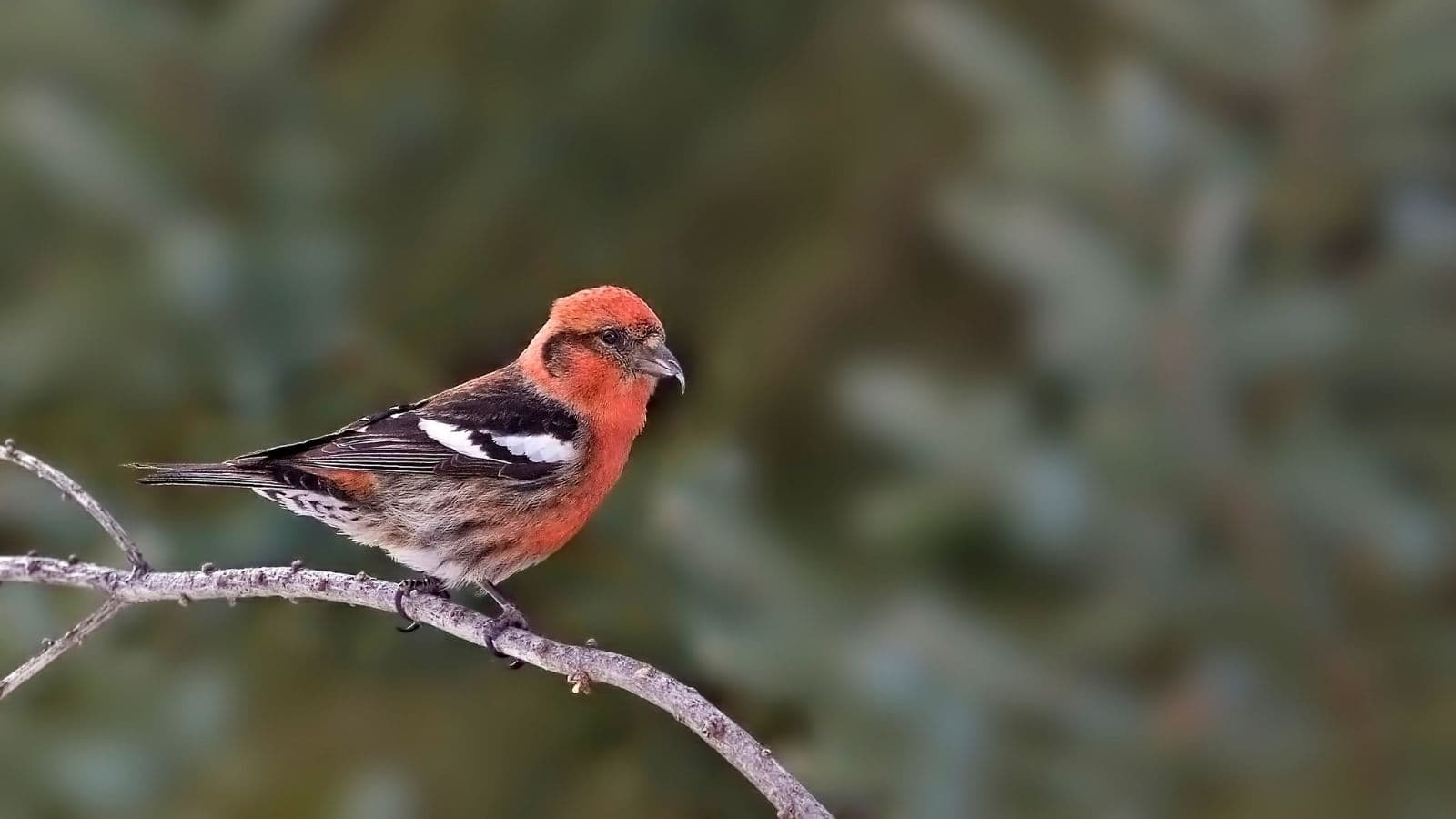
- Species Name: Loxia leucoptera
- Length: 15 cm to 17 cm
- Weight: 24 grams to 26 grams
- Wingspan: 26 cm to 28 cm
The red crossbill and white-winged crossbill are easy to mix up at a glance. However, I’ll help you sort them out as you travel throughout New Mexico.
Appearance
Let’s get the similarities out of the way first – the white-winged and red crossbill have the same unique beak shape. Males also boast rusty red coloration with dark wings and white wing bars.
However, the white-winged crossbill has much larger wing bars. They also rarely have yellow-orange coloration like the red crossbill.
Range
This finch species is a rare one in the state of New Mexico, so you won’t see it as often as its red crossbill counterpart. They usually stick to spruce forests so they can stock up on seeds.
Diet
These birds will stop at nothing to get their favorite tamarack and spruce seeds. They’re a delight to watch clamber all over cones to dig out the seeds.
These finches are unlikely to visit your feeder due to their scarcity, but they are fond of sunflower seeds…
Birdsong
Close your eyes and imagine the sound of a sprinkler. That’s the rapid-fire note the white-winged crossbill sings on, sounding like a chee-chee-chee or chr-chr-chr with few pauses.
Fun Fact
Their scientific name is a play on the Greek word leukopteros, a name that means ‘white-winged’.
Evening Grosbeak

- Species Name: Hesperiphona vespertina
- Length: 16 cm to 22 cm
- Weight: 38 grams to 68 grams
- Wingspan: 30 cm to 36 cm
With the coloration of a bumblebee and a heavier weight than most finches, the evening grosbeak stands out.
Appearance
The male evening grosbeak is quite impressive with his golden-yellow plumage, black wings, and white wing patch. If you look closely, you’ll see his characteristic yellow eyebrow
The female evening grosbeak has a light gray body with black wings and a similar white wing patch. She has a lovely hint of yellow on her neck and can be easily confused with a juvenile bird.
Range
New Mexico isn’t short on mountains, the favorite stomping grounds of the evening grosbeak. They’re a year-round resident in the northern part of the state, but more scarce elsewhere.
Diet
The evening grosbeak switches up their diet to suit the season (which makes them rather similar to humans in that regard). They enjoy seeds and berries during winter but eat insects in summer.
These birds adore sunflower seeds, but make sure to put them on a platform feeder. They’re a little too heavy for smaller bird feeders.
Birdsong
The evening grosbeak has a call that’s usually a repetitive, wheezing trill. However, this is not always the case…
Fun Fact
Evening grosbeaks are a little tricky to identify by their song. They’re known to be inconsistent and will switch up trills, scattered chirps, and burrs at will.
Black-Headed Grosbeak
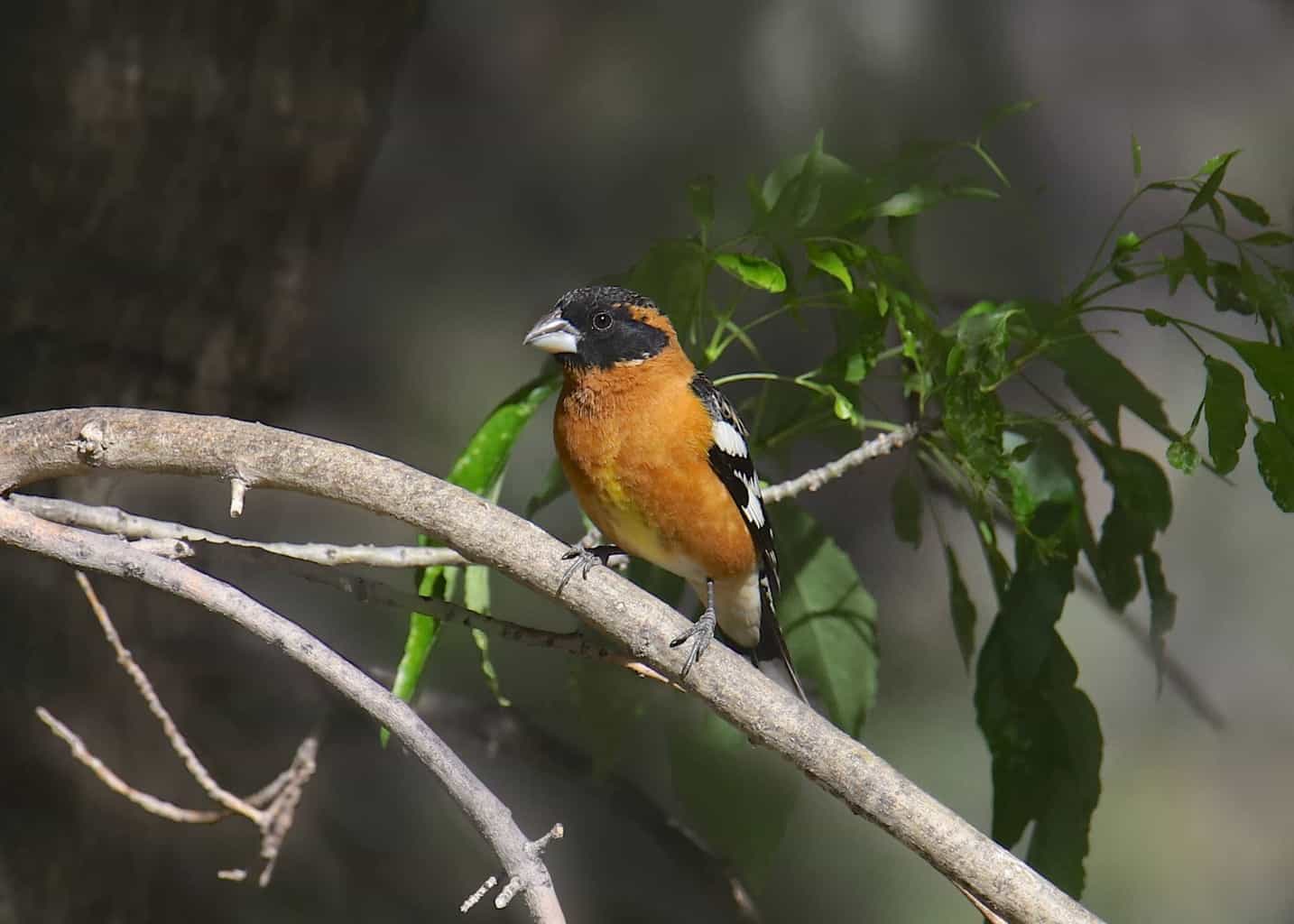
- Species Name: Pheucticus melanocephalus
- Length: 18 cm to 19 cm
- Weight: 34 grams to 48 grams
- Wingspan: 32 cm
This festive bird has a rather vibrant coloration. They’ll be easy to spot at a distance thanks to their large size, too.
Appearance
The male black-headed grosbeak has a black head, black wings, and a vivid orange stomach. Their wings are speckled with white like they’re under a sunbeam.
The female black-headed grosbeak has a lighter gray-black coloration streaking her face. Her throat and belly are a gentle tan-orange.
Range
The western portion of New Mexico sees a ton of these birds during breeding season. However, they tend to move through the eastern parts of the state only during migration.
Conifer forests and densely shrubby areas are their favorite places to roam. However, they sometimes appear in carefully tended suburban areas with places to hide and forage.
Diet
The black-headed grosbeak will eat just about anything. You’ll see them bouncing up and down as they search for berries, spiders, seeds, and fruit.
These finches are big fans of sunflower seeds and regular water sources. They’ll adore your backyard if it’s overgrown and you keep your birdbath clean!
Birdsong
The dulcet tones of the black-headed grosbeak are instantly rewarding. They let loose long, gentle warbles and cheerer-cheerer whistles.
Fun Fact
This diverse bird not only enjoys mountains and forests but even visits coastlines.
Cassin’s Finch
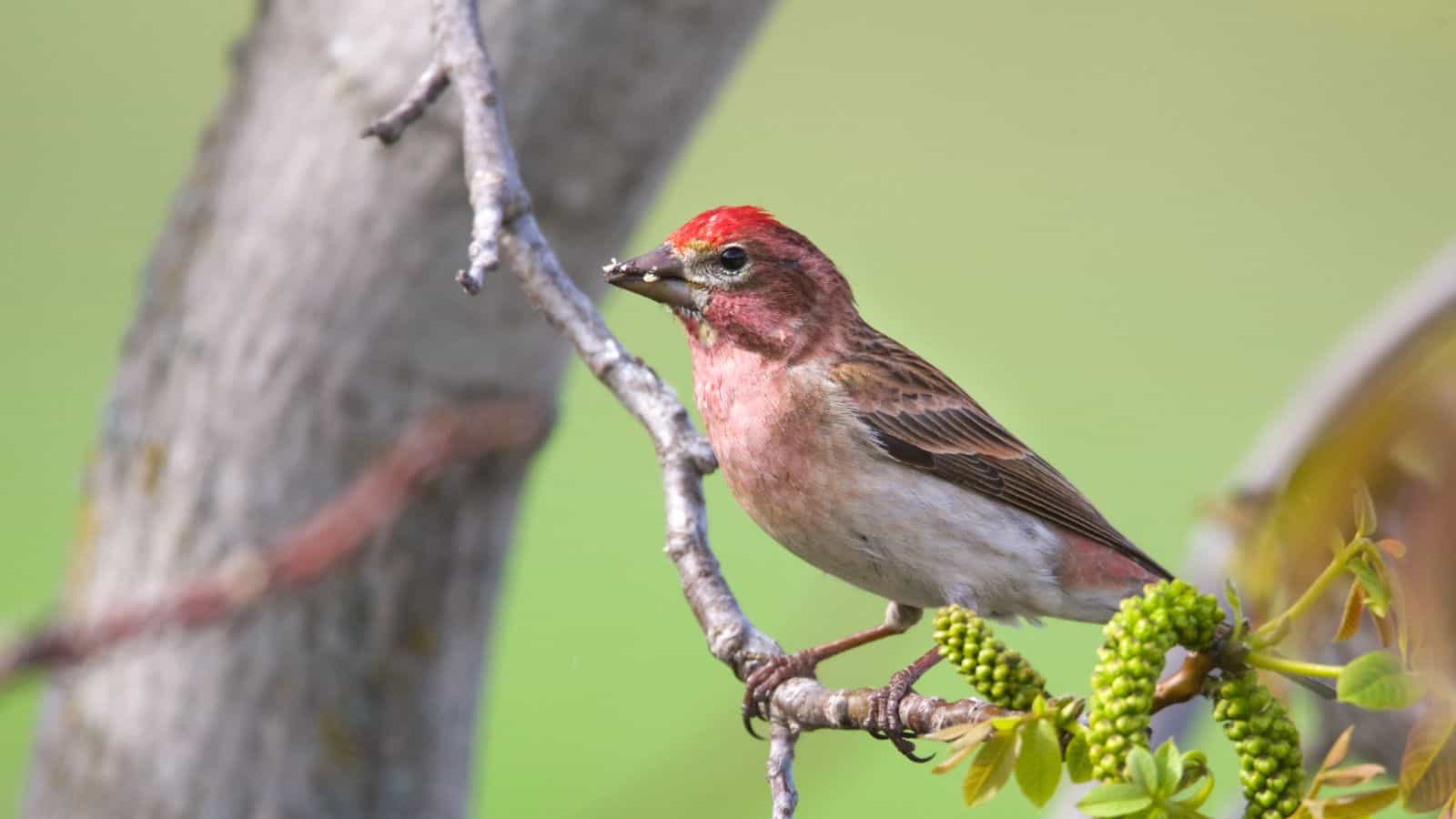
- Species Name: Haemorhous cassinii
- Length: 16 cm
- Weight: 24 grams to 34 grams
- Wingspan: 25 cm to 27 cm
Last but not least, we have the darling Cassin’s finch to add to your watch list. They’re less common in New Mexico, but determined bird watchers will be able to spot a few.
Appearance
The male Cassin’s finch is sparrow-like in his dark brown plumage but boasts a red streak along his face and neck. He has a lighter belly and a little red on his rump.
The female Cassin’s finch has a light brown body with a white stomach and plenty of streaks.
Range
Mountain forests are the go-to place for the Cassin’s finch, so hikers and campers should jot them down. They usually show up in southern New Mexico during non-breeding season, but in northern New Mexico year-round.
If you want to multitask, see if you can spot a few birds of prey, too!
Diet
Seeds, flower buds, and berries are their favorite foods, though they’ll switch things up a little during the winter months.
If you prefer backyard birding, stock up on sunflower seeds during the winter months.
Birdsong
This finch has a beautiful and dynamic warble that rises and falls.
Fun Fact
Their blushy coloration is such a standout feature, that scientists use it as a form of classification. The Cassin’s finch is part of a larger group dubbed ‘American rosefinches’.
New Mexico Is an Unexpected Haven for Finch Species
New Mexico isn’t usually the first state to come to mind for birdwatching, yet it’s a haven for finches. Backpackers, mountain climbers, and backyard birders alike have plenty to look forward to.
I highly recommend visiting New Mexico’s national parks to get the best of all worlds. You’ll have a front-row seat to several of the finch species as well as beautiful forests and mountains.
Curious about what else New Mexico has to offer the passionate bird watcher? Check out our guide on birds in New Mexico to learn more.

